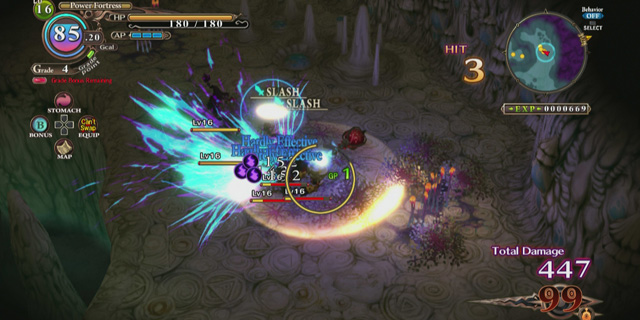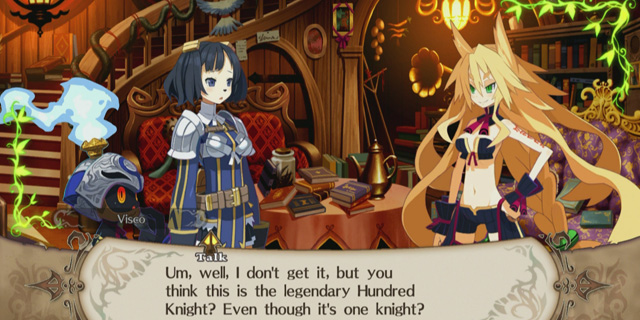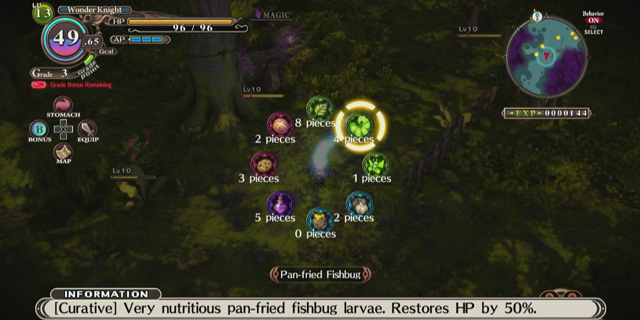
As a new game from the Disgaea team, The Witch and the Hundred Knight has a lot to live up to. Though it ventures into the realm of hack-and-slash action-RPG instead of the usual turn-based tactics, the team has retained its love of telling a story about the bad guys, complete with crazy plot twists. You play as the Hundred Knight, a creature summoned by Metallia, the Swamp Witch. As she is unable to leave the swamp, she sends you on missions for her, to spread the swamp further into the land of Madea. The main conflict: Metallia is locked in an endless struggle with her nemesis Malia, the forest witch.
The game begins with a tutorial, which is miserably long-winded. It’s an incredibly linear path describing what are very typical action-RPG mechanics. While some mechanics are unique, most of the tutorial could have been given without nearly as much text and voiced dialogue, and much of what is covered in the tutorial could be shown during the first few missions. There are a few things, such as raiding buildings, that are unique to the game and probably deserve to be covered in detail. There is also a complex system of weapon combos that is surprisingly not covered — though digging into it isn’t all that necessary to enjoy the game.
Once you get through the tutorial, it’s much more enjoyable. The game follows a top-down perspective, though the camera is manually controlled. Once you leave the swamp, pillars can be unlocked and used as fast travel points, allowing for a quick return. As you fight enemies and gain bonuses, it is important to remember that upgrades to your stats are only permanent if you leave the current map. There’s a significant risk-vs.-reward mechanic: the higher you raise the bonus gauge before returning, the better your permanent reward will be, though this progress is lost if you die.

As you travel, the Hundred Knight consumes giga-calories. To replenish them, you can consume food items, weapons or sometimes foes when they are weakened to a certain point. This serves to place time limits on exploration; you must continue fighting enemies to spend time outside the swamp. It isn’t overly punishing, with no real use for extra weapons beyond those you are using to battle, but it is fairly easy to maintain your meter. Consuming enemies will put “rocks” in your inventory-like stomach, limiting the number of other items you can carry. As a final note on gear: while weapons drop from enemies, this game is not a “loot game.” Using combos correctly, and choosing the right attack to engage an enemy with, will help you in battle far more than any amount of optimizing your stats.
As you might expect from the team that produced Disgaea, the characters are all quite quirky. They are varied and numerous enough to remain interesting as the game goes on. The Hundred Knight is a silent protagonist, though you can use different emotional responses to other characters and influence their reactions. Despite the fact that the hack-and-slash genre is usually paired with simple and often-forgettable story segments, the Hundred Knight is given the ability to react to others instead of simply going through the story. At the beginning of the game, the Hundred Knight is an intellectual infant. As you play, moral decisions arise: and the choices you make may not completely fall in line with Metallia’s wishes.

The Witch and the Hundred Knight combines a world you might expect to see in a Grimm fairy tale and a cast of characters that feel decidedly original — though the influences coming through from the Disgaea series are present, for those who are looking. The game ultimately stands on its own as a great console hack-and-slash title, using its place as a niche Japanese game to free itself from the expectations that genre would otherwise force upon it.
Pros: Fun twist on hack-and-slash, lush colorful environments
Cons: Unnecessarily long tutorial, awkward camera



















